Japan
Wood Products Prices
Dollar Exchange Rates of 25th
Nov
2023
Japan Yen 149.00
Reports From Japan
Economy contracts - a challenge for government and
Bank of Japan
Japan's economy contracted in the third quarterof 2023
ending two quarters of expansion. A dip in exports,
especially to China and weak domestic consumption
because inflation has undermined household spending.
The latest data underscores the policy challenges faced by
the government and the Bank of Japan.
Provisional GDP was forecast to have fallen by over 2% in
the third quarter compared to a year earlier after expanding
4.8% in April-June quarter. The economy contracted 0.5%
in the third quarter from the previous quarter after
expanding 1.2% in the second quarter. Thithe third quarter
contraction was larger than expectated.
The disappointing GDP figure was partly driven down by
weaker than expected domestic capital expenditure which
contracted 0.6% in the third quarter from the second
quarter.
Private consumption in Japan was flat in the third quarter
and it is likely that, because real household incomes will
continue to slide until the middle of next year, consumer
spending will not support growth.
Against this background the government downgraded its
assessment of economic prospects for the first time in 10
months, saying the economy is recovering moderately but
"appears to be pausing in part" on weak domestic demand.
Among the key economic indicators the Cabinet Office cut
its view on capital spending for the first time in nearly two
years.
See:
https://english.kyodonews.net/news/2023/11/523ff7a4f770-japan-cuts-economic-view-1st-in-10-months-on-weak-domestic-demand.html
Improved rights protection for foreign workers
Changes are planned for Japan's controversial trainee
programme for foreign nationals. A panel has
recommended improved rights protection with increased
flexibility for workplace changes and more rigorous
monitoring. It is anticipated that the final report will form
the basis of a Bill to be submitted to parliament next year.
If approved, this will end the current Technical Intern
Training Programme which has been in place since 1993.
Originally designed to transfer skills to developing
countries, the programme has been abused by firms
bringing in inexpensive labour. There have been cases
when trainees ran way due to unjust treatment and with
cases of abuse within the programme, including unpaid
wages and harassment.
See:https://www.japantimes.co.jp/news/2023/11/25/japan/technical-intern-final-report/
Osaka Expo to have world's largest wooden structure
The Japanese company, Sou Fujimoto Architects has
created the centre piece for the 2025 Oaska Expo, it is a
large circular 3-story building using cross-laminated
timber combining traditional and modern timber building
technology .
The huge structure almost 2 km in diameter is made of
local made of wood and is being built on an artificial
island in Osaka Bay. The structure will encircle the
island. The design is a purposeful nod to Japanese
tradition as timber construction is commonly used for
temples. Once completed the structure will become the
world's largest wooden buildings. However, the high
construction cost and recent cost overruns have drawn
criticism.
Expo Osaka 2025 will run between 13 April and 13
October 2025 under the theme ‘Designing Future Society
for Our Lives’ which advocates for a place where cutting-
edge technology will be used to create new ideas and
alleviate global challenges currently plaguing humankind.
See: https://mymodernmet.com/expo-2025-sou-fujimoto-construction/

Discounts on mortgages for families
A Japanese government-related financial institution is
going to offer special discounts on new mortgages for
child-rearing families. The Japan Housing Finance Agency
offers fixed-rate loans of up to 35 years in collaboration
with private financial institutions.

Under the plan, households with children aged under 18 at
the time of application would be eligible for reduced
annual interest rates. The discounts would be valid for the
first five years. Their size would depend on the number of
children per family.
The plan is in the government's supplementary Budget
Bill. The discounts could go into effect as early as February 2024 if the
Diet approves the Bill during its
current session which ends soon.
See: https://www3.nhk.or.jp/nhkworld/en/news/20231124_25/
Yen/US dollar up from recnt lows
The yen was trading just over 150 against the US dollar in
late November slightly above the low of 151 seen recently.
The weak yen and its impact on import costs underscores
the fragility of the Japanese economy and the complexities
for the Bank of Japan. It also strengthens the case for the
government’s new economic package aimed at curbing
rising living costs which is expected to include subsidies
and payouts to low-income households.
See
https://www.cnbc.com/2023/11/15/japan-q3-economy-shrinks-far-more-than-expected.html
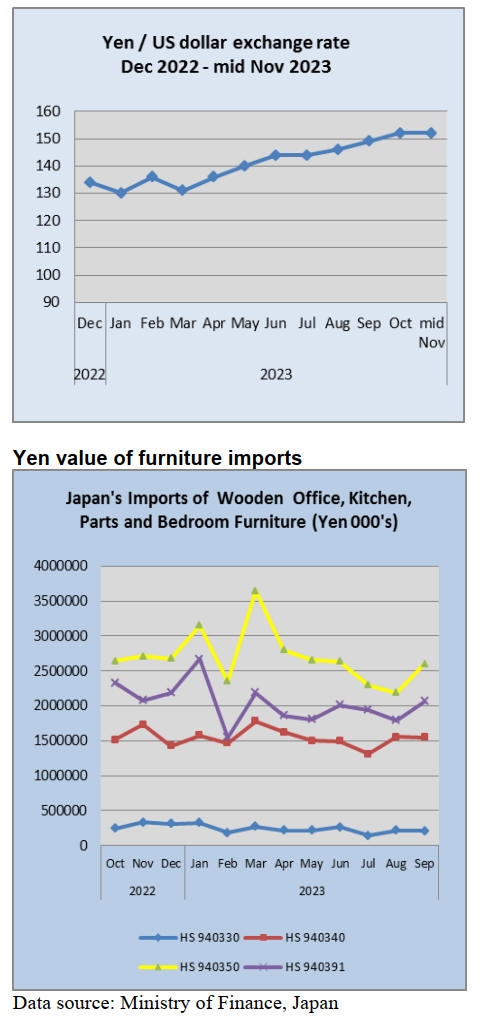
September wooden office furniture imports
(HS940330)
In September, shippers in China and Malaysia once again
were the main shippers of wooden office furniture
(HS940330) to Japan respectively accounting for 77% and
19% of the total value of imports. Shippers in China,
Malaysia and Germany accounted for around 90% of the
value of imports of wooden office furniture in September.
The value of September arrivals from China were up
compared to August and arrivals from Malaysia were
sharply higher compared to a month earlier.
Year on year, the value of September 2023 imports of
wooden office furniture was down 12% and there was also
a decline in the value of imports compared to the level
reported for August.
In August there was a marked increase in the number of
countries shipping wooden office furniture to Japan but in
September the number had fallen significantly.
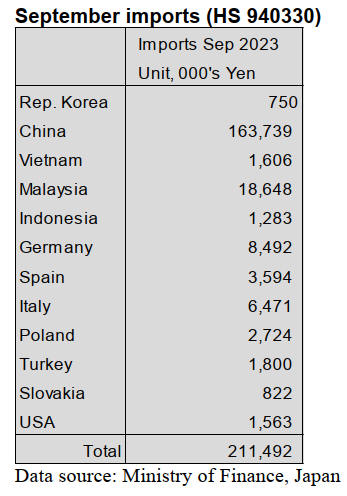
September kitchen furniture imports (HS 940340)
As in previous months, shippers in the Philippines and
Vietnam together accounted for the bulk of Japan’s
imports of wooden kitchen furniture.
In September the top four shippers were the Philippines,
Vietnam, China and Thailand but in September arrivals
from the Philippines, Vietnam and China were all down
compared to levels in August.
Year on year the value of wooden kitchen furniture
imports in September dropped 6% following the first signs
of a recovery that emerged in August.
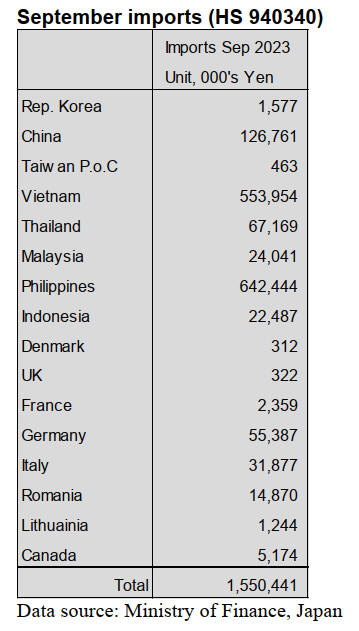
September wooden bedroom furniture imports
(HS940350)
Since April this year there was a steady decline in the
value of Japan’s imports of wooden bedroom furniture
(HS940350) but this downward trend was reversed in
September when the value of imports jumped 19%.
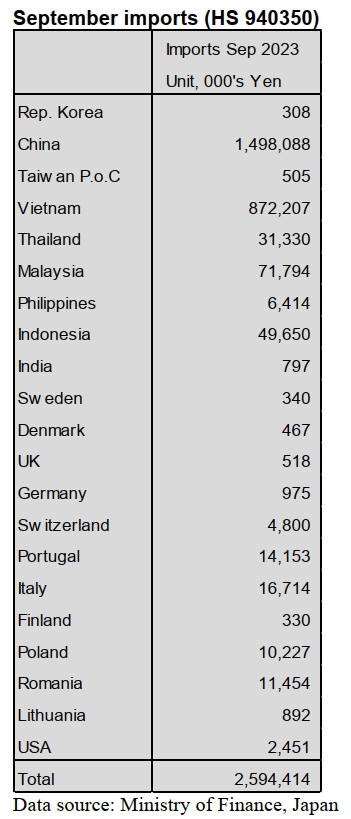
The steady weakening of the yen against the US dollar
which is the trading currency makes it difficult to assess
the precise causes behind the September jump in the value
of imports especially as consumer sentiment in Japan has
taken a hit from the impact of rising prices.
China and Vietnam were the main suppliers of wooden
bedroom furniture in September, together accounting for
over 90% of the value of imports. The value of September
imports from China was up month on month as they were
for Vietnam, Malaysia and Indonesia, the top four shippers
in September.

September wooden furniture parts imports (HS 940391)
After declines in July and August the value of Japan’s
imports of wooden furniture parts (HS940391) rose 15%
in September compared to a month earlier and compared
to September 2002 there was a 13% increase.
In September import data published by the Ministry of
Finance in Japan shows there were 28 shippers of wooden
furniture parts in September, the highest number recorded
this year.
The top suppliers of wooden furniture parts in September
were China (45%), Indonesia (29%), Malaysia 12% and
Vietnam 11% and each of the top shippers saw the value
of their imports by Japan rise, especially Malaysia where
in September there was an almost 25% increase month on
month.
Trade news from the Japan Lumber Reports (JLR)
The Japan Lumber Reports (JLR), a subscription trade
journal published every two weeks in English, is
generously allowing the ITTO Tropical Timber Market
Report to reproduce news on the Japanese market
precisely as it appears in the JLR.
For the JLR report please see:
https://jfpj.jp/japan_lumber_reports/
Export trends of logs and lumber
Volume of exported logs during January to September,
2023 was 1,174,000 cbms, 19.4 % more than January to
September, 2022. The total log exports are 17 billion yen,
10.4 % more than the same period last year. On the other
hand, volume of exporting lumber during January to
September, 2023 are 99,000 cbms, 28.6 % less than the
same period last year.
The total lumber exports are 4.6 billion yen, 37.6 % less
than the same period last year. It seems that the weak yen
has not influenced the exporting business. A forecast for
October to December will be would be the same situation
from now. There is a possibility that exporting logs in
2023 will recover and exporting lumber in 2023 will
decrease two years continuously.
Exporting domestic logs and lumber started to rise since
2013 and it stopped rising in 2019. Then, it started to rise
again in 2020 and in 2021, exporting logs and lumber
recorded the highest volume and amount. The yen started
to depreciate against the US dollar in 2022 and total
wooden product exports were 50 billion yen. It was
necessary to pay close attention to export trends of logs
and lumber in 2023.
Exporting cedar logs during January to September, 2023
are 1,042,000 cbms, 30.7 % higher than the same period
last year. Cedar logs for China are 1,038,000 cbms, 26.0 %
higher than the same period last year. Cedar logs for South
Korea, Taiwan and Vietnam decline slightly.
Exporting cedar lumber is 63,000 cbms, 34.5 % down
from the same period last year. Cedar lumber for the
U.S.A. is 24,000 cbms, 25.7 % down from the same period
last year. Cedar lumber for China is 41,000 cbms, 11.9 %
less than the same period last year. A decrease in cedar
lumber for the U.S.A. is because the lumber market is low
in the U.S.A.
Exporting logs to China is very active in Kyushu region
and the latest price of log is slightly below $110, C&F per
cbm. Since the economy in China is low, inquiries for
cedar and cypress are not a lot.
Japanese exporters deliver logs to ports by 10,000 –
11,000 yen, per cbm. However, the price of logs for
biomass power fuel and papermaking has been rising in
Japan so Japanese exporters focus on selling the logs in
Japan.
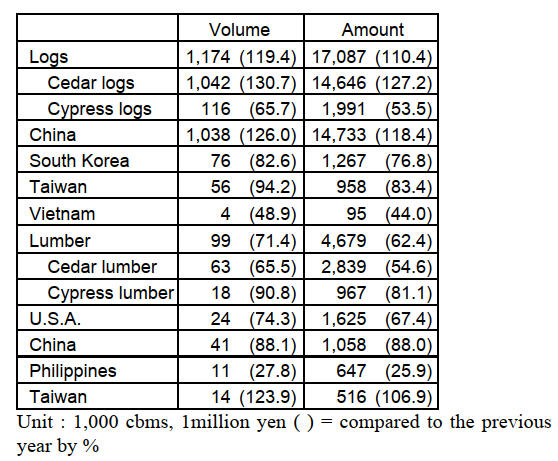
Sample building materials (deliverey to architects and
interior designers)
Design Future Japan Co., Ltd. started a service called
‘Material Bank Japan’. The service is about delivering
several companies’ building materials as samples to
licensed architects and interior designers. The company
had been conducting a demonstration experiment for the
service since January 2023 and the company received a
good rating from the licensed architects and interior
designers. About 200 building materials companies
participate in this service.
On 18 October a webinar was held for licensed architects
and interior designers. Everyone is able to register the
service and is able to use the service with no charge.
Consumers are able to choose the sample building
materials from about 50,000 kinds. Also, it is able to send
e-mails to the building material company’s staff through
the service. It is able to save what you have ordered
before.
The company has a system which reports about Co2
reduction or reduction in delivery cost when you use the
service.
The service of ‘Material Bank’ began in the U.S.A. and
about 110,000 architectural designers and about 90 % of
major design companies use the service today.
The president of Design Future Japan says that it is
important to raise the clients’ and building material
companies’ satisfaction.
The service in the U.S.A. has 500 building material
companies so the service in Japan also aims to have 500
building material companies.
South Sea logs and lumber
Movement of hardwood lumber would depend on an
exchange rate fluctuation. The price of hardwood lumber
in South Asia won’t decrease so Japanese buyers watch
the foreign exchange carefully to reduce the import cost.
New starts are still low so as a number of stores and there
are not many orders for interior finishing work of stores.
One of the reasons is that high prices of commodities
influenced the selling price of stores. Therefore, Japanese
buyers hesitate to procure a lot of lumber. South Asian
shippers understand the circumstances in Japan so they do
not sell the productactively. Some Indonesian or Chinese
manufacturers lowered the price of laminated boards but
the price of laminated boards in Japan decreased just a
little bit due to the weak yen.
The price of South Sea lumber are still high. There are
many inquires for truck body materials. There is a certain
number of orders for deck materials when the yen
depreciates against the US dollar.
Review the Technical Intern Training Programme
The Japanese government held a meeting for reviewing
the Technical Intern Training Program on 18th October,
2023. The government will set up a new system for
securing employees and training employees.
The new system shows that it is able to change the
company if the employees work at a company for a year.
The current system of the Technical Intern Training
Program is about international contribution by training
employees. There are 88 kinds of jobs and it is able to live
in Japan for maximum 5 years. However, it is unable to
transfer to other companies. If the working conditions
were not good, then a foreign worker would disappear
from the company. This situation is actually happening in
Japan and it is becoming a serious problem. To avoid the
disappearance, the new systems shows that a period of
residence in Japan will be maximum 3 years.
If the foreign workers passed the test of skills and
Japanese-Language Proficiency Test and then worked at a
company for a year, the foreign workers would be able to
transfer to another company but it has to be in the same
business areas.
There had been a difference between Technical Intern
Training and Specified skills visa but it changed to be
simple. If the foreign workers passed the high level tests,
the foreign workers are able to extend their stay for
maximum 5 years. Even if the foreign workers failed the
high level tests, the foreign workers are able to extend the
stay for one more year.
However, there is a concern that the foreign workers might
transfer to companies, which are located in the cities with
good salaries, from countryside where a shortage of
workers occurring.
|